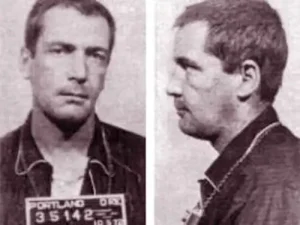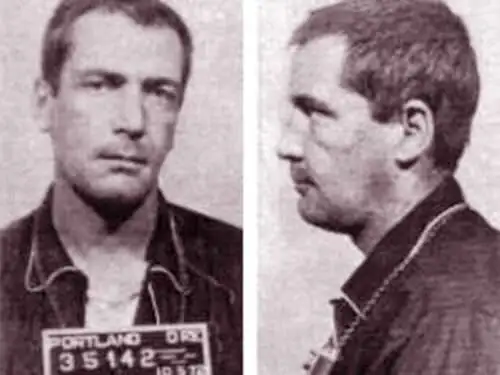Gary Gilmore was executed by the State of Utah for two murders that committed during robberies
According to court documents Gary Gilmore who was a life long criminal would murder a man during a robbery and then days later would murder a second man during another robbery
Gary Gilmore would be arrested, convicted and sentenced to death
Gary Gilmore refused to appeal his death sentence and demanded to be put to death
Gary Gilmore would be executed January 17, 1977 by firing squad.
Gary Gilmore Photos

Gary Gilmore FAQ
When was Gary Gilmore execution
Gary Gilmore was executed January 17, 1977
How was Gary Gilmore executed
Gary Gilmore was executed by firing squad
Gary Gilmore Case
He was executed 42-years ago, but Gary Gilmore’s is still remembered for opening the doors for capital punishment.
Gilmore was executed in January 1977. It was the first execution after the U.S. Supreme Court declared it constitutional once again. In 1972, the nation’s highest court found it “cruel and unusual” form of punishment and made it unconstitutional.
State’s then revised their statutes and Gilmore was the first case to U.S. Supreme Court’s new view on capital punishment.
In September 1976, Gilmore was convicted of a double murder in Utah County.
On July 19, 1976, he murdered 24-year old Max Jensen who was working at a service station in Orem. The following night he walked into a Provo motel and shot Bennie Bushnell, the night manager. He took the money and left.
He was arrested after someone saw him throw a gun into the bushes right after the shooting.
Three months after he was arrested, Gilmore was convicted of capital murder and ordered to die. Gilmore chose to die by firing squad instead of the other option, hanging.
University of Utah law professor and former federal judge Paul Cassell still uses Gilmore’s case history in teaching law courses.
“What made the Gilmore case death-eligible was that it was a murder for money,” he said. “It was an armed robbery.”
But Gilmore gained notoriety when the rest of the country, as well as foreign countries, learned that he would be the first to be executed after the supreme court decision.
“Utah and other states passed new modern death penalty laws,” said Cassell. “Gilmore was the first case that the modern death penalty was carried out.”
From the outset, Gary Gilmore wanted to be executed and didn’t want anyone to stop him. At a 1976 Board of Pardons hearing, Gilmore spoke of that desire.
“I’ve simply accepted the sentence that was given to me,” he told board members. “I’ve accepted sentences all of my life.”
But others wanted to save his life.
His mother filed an appeal but the U.s. Supreme Court refused to hear her case.
His original execution date was set for November 15th, 1976. The Utah state prison started making arrangements.
“Traditionally there have been five men on the firing squad,” Warden Sam Smith told reporters. “Those men are armed with high powered rifles. Four of them will have actual bullets, one will be shooting a blank.”
But against his wishes, the ACLU intervened and blocked the execution on three occasions.
Their main objection was that it would open the floodgates for executions nationwide.
“It would lead to more insanity around the whole issue of the death penalty,” said Shirley Pedler of Utah’s ACLU chapter. “And the implementation of the death penalty is an insane issue.”
The governor twice issued stays of execution. He wanted the board of pardons to decide if death was appropriate in Gilmore’s case.
During the 1976 board of pardons hearing, Gary Gilmore made his intentions clear and even suggested that Utah was getting cold feet.
“It seems like the people, especially the people of Utah want the death penalty and they don’t want executions,” he said. “And when it became a reality that they might have to carry one out, well they started backing off on it. Well, I took them literal and serious when they sentenced me to death.”
The stays of execution angered Gilmore. In November he attempted suicide, recovered, but tried it again the next month.
His execution was now set for January 17th, 1977. National and international media converged at the Utah state prison.
Protestors held vigils. the ACLU made one last attempt to save his life but it was denied thirty minutes before his execution.
An ABC reporter described it this way: “The warden having read aloud the legal order that Gilmore must be shot for his crime asked quietly for any last words. Gilmore said let’s do it.”
At 8:05 a.m. a prison official received a call from the warden. The official was surrounded by reporters away from the room where Gary Gilmore was shot.
“The order of the court has been carried out,” the unidentified official told reporters. “Gary Mark Gilmore is dead.”
On January 17th, 1977, Gilmore’s wish was carried out. He was shot four times through the heart.
Reporters were given access to the room where Gilmore was shot. They took pictures of bullet holes, inspected it from top to bottom and posed in front of the chair for additional pictures.
Years later the ACLU was prophetic.
“As a result of the Gary Gilmore execution we then saw hundreds of executions in the decades that followed because Gilmore signaled that in modern America, you can have a death penalty statute that survives constitutional scrutiny,” Cassell said.
Gilmore murdered two people and was convicted by his peers. His own uncle once called him a coward. That same uncle later began visiting Gilmore at the prison. Vern Damico was Gilmore’s last visitor before he was shot.
“It was very upsetting to me but he got his wish,” said Damico following the execution. “But he did die and he died in dignity.”
It was another 19 years before there was another execution by firing squad in the United States.
It took place at the Utah state prison when John Albert Taylor was executed.
According to press accounts he did it to embarrass Utah’s barbaric method of execution.
The following year, the legislature changed future executions to lethal injection. But lawmakers grandfathered those condemned to die prior to 1996 and allowed them to choose their manner of death.
In June 2010 Utah again became the focus of capital punishment. Ronnie Lee Gardner became just the third person to be killed by a firing squad. Gardner’s crime happened before the legislature changed the law and he chose the firing squad.
Ron Lafferty was also on death row and chose the firing squad. His crime of a double murder in American Fork happened in 1984. But Lafferty died November 11 of natural causes while still in prison.
https://www.abc4.com/news/justice-files/the-justice-files-the-execution-of-gary-gilmore-2/








